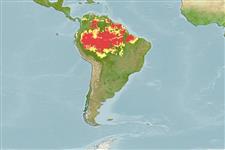Classification / Names
Common names | Synonyms | Catalog of Fishes (gen., sp.) | ITIS | CoL | WoRMS | Cloffa
Actinopterygii (ray-finned fishes) >
Beloniformes (Needle fishes) >
Belonidae (Needlefishes)
Etymology: Potamorrhaphis: Greek, potamos = river + Greek, rhaphis = needle (Ref. 45335).
Environment / Climate / Range
Ecology
Freshwater; pelagic; depth range 0 - ? m. Tropical; 23°C - 26°C (Ref. 2059), preferred ?
South America: Amazon and Orinoco River basins, and the Guianas.
Size / Weight / Age
Maturity: Lm ? range ? - ? cm
Max length : 29.1 cm TL male/unsexed; (Ref. 40653); common length : 12.3 cm OT male/unsexed; (Ref. 10994)
Short description
Morphology | Morphometrics
Forms schools at the surface. Prefers to inhabit marshes, small slow-moving creeks or even in main river beds, in the slowest parts of meandering streams next to banks (Ref. 35237). Voracious carnivore which appears to have a primarily nocturnal habit (Ref. 27188). During reproduction, the male positions itself beside the female or crosswise in front of her. Sometimes the male touches the female with his side, pushing her aside in an oblique position, with their heads oriented downwards. The couple settles next to a bush where the female spawns her eggs (15 to 40). Eggs adhere to plants by means of sticky filaments which are 2 to 3 mm long. At 27-30°C, incubation lasts for 9 to 10 days. Larvae are pelagic and carnivorous (Ref. 35237). Maximum length 40 cm TL in Keith et al., 2000 (Ref. 35237).
Life cycle and mating behavior
Maturity | Reproduction | Spawning | Eggs | Fecundity | Larvae
The eggs are attached to underwater vegetation. At 27-30 deg. Celsius the larvae hatch after 9 - 10 days. The larvae are pelagic carnivores.
Collette, B.B., 1982. South American freshwater needlefishes of the genus Potamorrhaphis (Beloniformes: Belonidae). Proc. Biol. Soc. Wash. 95(4):714-747. (Ref. 10994)
IUCN Red List Status (Ref. 115185)
CITES (Ref. 94142)
Not Evaluated
Threat to humans
Harmless
Human uses
More information
Age/SizeGrowthLength-weightLength-lengthLength-frequenciesMorphometricsMorphologyLarvaeLarval dynamicsRecruitmentAbundance
ReferencesAquacultureAquaculture profileStrainsGeneticsAllele frequenciesHeritabilityDiseasesProcessingMass conversion
Tools
Special reports
Download XML
Internet sources
